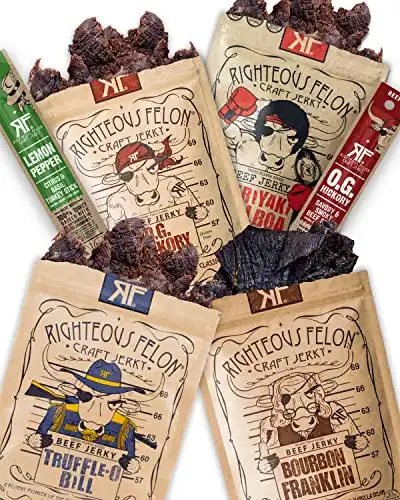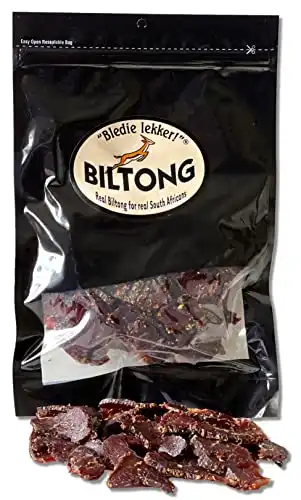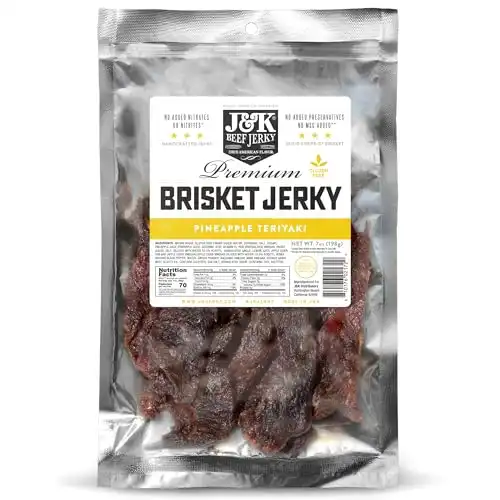12 Exotic Jerky Types to Try for a Unique Snack Experience
Explore over 22 exotic jerky varieties for a unique snacking experience, from garlic black pepper to Cajun, offering diverse flavors beyond traditional options.

Exotic jerky offers a unique twist on the classic snack, featuring a variety of dried meats seasoned to perfection. The term “jerky” finds its roots in the Quechua word “charqui,” meaning “dried meat.” While historically crafted from beef or buffalo by Native Americans and early settlers, today’s jerky enthusiasts can indulge in an array of protein options, from chicken to turkey and beyond.
When it comes to the best exotic jerky, preferences can vary widely, but from tantalizing appetizers to post-workout refuels, exotic jerky caters to diverse tastes and preferences. Step off the beaten path of mainstream options, and explore the flavorful world of specialty jerky offerings.
Disclosure: As an Amazon Associate, this site earns from qualifying purchases. Thank you!
1. Flavored Beef Jerky
Beef is the “standard” meat for jerky, but there are plenty of exotic flavors that go beyond black pepper, garlic, onion, or teriyaki. Explore the diverse world of exotic beef jerky flavors:
- Spicy Chipotle: Infused with the smoky heat of chipotle peppers, this jerky packs a punch for spice lovers.
- Lemon-Pepper Flavor: Classic lemon and pepper flavors come together for an exciting twist on beef jerky.
- Sweet and Savory: A delightful blend of sweetness and saltiness, perfect for those who enjoy a balance of flavors.
- Honey BBQ: Sweet honey combined with tangy barbecue sauce creates a mouthwatering jerky experience.
- Sriracha Teriyaki: For an Asian-inspired twist, try this fusion of spicy Sriracha and classic teriyaki flavors.
- Peppered: Cracked black pepper adds boldness and depth to the rich beef flavor, a timeless favorite among jerky enthusiasts.
- Cajun Flavor: Bursting with spicy Cajun seasoning, this beef jerky delivers a bold kick and aromatic blend of herbs and spices, perfect for those craving fiery flavor.
2. Alligator Jerky
Alligator jerky is among the many exotic options available. Its flavor is distinct, resembling a gamier version of chicken or beef, appealing to some and not to others. Despite misconceptions about toughness, properly prepared alligator meat is tender. If you haven’t tried it, consider picking up some alligator jerky during your next grocery run.
3. Wild Boar Jerky
Wild boar has the same texture as pork and is leaner than beef. Wild boar jerky can be sweetened up with sugar but also has a natural hickory flavor. Wild boars are an invasive species, so there is no limit on hunting them in most states. You can likely track some down even if you aren’t a hunter.
4. Ostrich Jerky
Ostrich meat varies in tenderness and is ideal for jerky when heavily dried and seasoned. Known for its meaty flavor, ostrich jerky is popular among carnivores. Raised for meat worldwide, ostriches are readily available and prized for their leanness, appealing to health-conscious individuals. With its mild flavor, ostrich meat complements bolder seasonings, catering to those who prefer milder tastes.
5. Elk Jerky
The elk is a large, deer-like creature native to North America. The meat from the elk is a very dark red and has a significantly different flavor from beef or pork. This jerky has a strong, rich flavor that goes well with other spices like chili powder, garlic powder, onion powder, and cayenne pepper.
6. Pork Jerky
It may not be “exotic” but like beef, pork is extremely versatile and can be paired with really exotic flavors. Pork Jerky can be dried or smoked, with the most common flavors being teriyaki, garlic black pepper, lemon pepper, and Cajun.
7. Kangaroo Jerky
Kangaroo jerky is a lean, protein-packed snack that is perfect for the health-conscious eater. It’s made from a good cut of kangaroo meat, which is low in fat and high in protein. It can be “dried” or “smoked,” and the most popular flavors are teriyaki, garlic black pepper, and lemon peppers.
8. Turkey Jerky
Turkeys are native to North America, but nowadays they’re also domesticated all around the world because they’re such a popular food (similar to geese). The best turkey jerky is made from dark meat, which is low in fat and high in protein. You can “dry” or “smoke” it, and the most popular flavors are teriyaki, garlic black pepper, and lemon pepper.
In the video, Living Traditions Homestead explains –
Living Traditions Homestead
- Introduction to Homemade Turkey Jerky: The video provides an introduction to making homemade turkey jerky as a healthier alternative to sweet treats during the holiday season.
- The versatility of Recipe: The recipe is versatile and can be used for various meats like turkey, beef, venison, and even rabbit, allowing for flexibility based on availability and preference.
- Preparation Process: The preparation process involves a two-day procedure. On the first day, the brine is made, and the turkey is sliced and marinated overnight.
- Brine Ingredients: The brine consists of common household ingredients like soy sauce (or a soy alternative like coconut aminos), Worcestershire sauce, brown sugar, salt, paprika, garlic powder, and onion powder.
- Turkey Preparation: The turkey breast is prepared by removing the skin and bone, ensuring it’s lean and ready for slicing.
- Slicing Technique: Slicing the turkey breast into uniform, quarter-inch thick pieces is essential for consistent drying and flavor absorption.
- Brining Process: The sliced turkey is then placed in the brine, ensuring it’s well-coated, and left to marinate overnight in the refrigerator.
- Smoking Method: One method demonstrated involves using an electric smoker preheated to 175 degrees Fahrenheit with applewood chips for smoking, ensuring consistent heat and flavor.
- Dehydrating Method: Alternatively, the video showcases using a dehydrator set to 165 degrees Fahrenheit for those without a smoker, providing a smoke-free option.
- Final Tips: It’s advised not to over-smoke the jerky, as the thin meat can absorb too much smoke flavor. Additionally, smaller pieces are recommended for dehydrating, while larger pieces are suitable for smoking.
9. Antelope (Biltong) Jerky
Antelope jerky is a type of jerky that’s made from antelope meat, or biltong. It’s usually prepared with a strong spice mixture including paprika, salt, sugar, and garlic powder. It needs a lot of time to marinate in the refrigerator before being consumed, but it’s worth the wait!
10. Southeast Asian Jerky
This exotic jerk is typically made from beef, pork, chicken, or water buffalo. The Southeast Asian version can be spicy with ingredients like teriyaki sauce. Typical flavors include soy sauce and lemon pepper seasoning. As for preparation methods, it may be dried or smoked before consumption.
11. Duck Jerky
Duck Jerky is created from the dark meat of a duck. It’s then “dried” or “smoked” to preserve it. The most popular flavor is teriyaki, but you can also enjoy garlic black pepper, or lemon pepper. There are duck jerky recipes readily available on the internet, so you don’t have to go hunting for one at your local grocery store! It’s also very economical for producers and commonly sold “for dogs.”
12. Salmon Jerky
Salmon jerky is made by drying or smoking either salmon fillets or salmon steaks. It tastes incredibly meaty, making it a favorite among carnivores. Another benefit of this jerky is that it’s low in fat and high in protein so it’s great for people who are looking to eat healthier. The best part about this kind of jerky is that it doesn’t have any effect on your conscience – perfect for pescatarians!. The flavors are subtle, which makes it perfect for people who don’t like very strong flavors.
13. Venison Jerky
Venison jerky is very similar to beef jerky in that it’s not “exotic” but is still exceptionally versatile. Venison is made by drying or smoking (like most types of jerky), and the most common flavors are teriyaki, garlic black pepper, or lemon pepper. Venison Jerky is a relatively new type of- jerky that has been gaining popularity in recent years. Venison is the term for meat of deer, and it’s traditionally made by curing or drying, then seasoning with various spices like garlic, pepper, soy sauce, and vinegar. The most common flavor is teriyaki sauce.
14. Bison Jerky
Bison jerky is made of bison meat, which is low in fat and high in protein. The most common flavors are teriyaki, garlic black pepper, or lemon pepper. This type of jerk can also be dried or smoked before it’s consumed. The best Bison Jerky maker, Native-owned Tanka Bar, also helps restore the grasslands and historic prairies of North America.
Also – check out yak jerky, which is similar in leanness and protein content.
15. Brisket Jerky
Brisket Jerky is a type of jerky that’s made from brisket meat (usually the flat cut, not points). Brisket Jerky is a type of jerky that’s dry or smoked before it’s consumed. The overall flavor is a dry, salty snack with a smell similar to roast beef. A good wood can add flavor to brisket.
16. Wagyu Jerky
Wagyu Jerky is made from the finest cuts of beef which are then “dry” or “smoked” before being consumed. The common flavors are teriyaki, garlic black pepper, or lemon pepper. Wagyu jerky is a high-quality type of jerky that’s superior to beef jerky due to its high-quality meat and less salty taste. It’s perfect for individuals who enjoy beef jerky but want something with a more delicate taste.
17. Goose Jerky
Goose Jerky is made by drying or smoking goose meat. The most common flavors are teriyaki, garlic black pepper, or lemon pepper. Goose Jerky is a type of jerky that’s unlike any other because of its distinct flavor. It tastes like bacon but with less saltiness. The best part about Goose Jerky is that it’s low in fat and high in protein – making it perfect for people who are on a diet.
18. Rabbit Jerky
Rabbit Jerky is made in America by curing or drying the rabbit meat to preserve it. The most popular flavors are teriyaki, garlic black pepper, or lemon pepper. The flavor is not overpowering, so it’s perfect for people who don’t like strong flavors in their jerky. Rabbit Jerky can be consumed raw or cooked because it doesn’t have any cholesterol. The best part about this type of jerky is that it’s low in fat and high in protein – making it perfect for people who are on a diet.
19. Snake Jerky
Snake Jerky is made with the finest snake meat available, so it’s both healthy and delicious. The meat is moist, tender, and has a mild flavor. Python is the most common species used for snake jerky.
20. Trout Jerky
Trout jerky is made with the finest trout meat available. Trout jerky is a healthy alternative to other less nutritious types of jerky, and has a much lighter flavor. Trout jerky is much leaner than beef, but it still contains high levels of protein. The oily fish are seasoned with spices or seasonings before being dried into jerky form.
Tips for Choosing and Storing Exotic Jerky
When it comes to enjoying exotic jerky, selecting high-quality products and storing them properly is essential to ensure freshness, flavor, and texture. Here are some tips to help you make the most out of your exotic jerky experience:
Choosing High-Quality Products
- Check the Ingredients: Look for exotic jerky made from high-quality meat sources without added preservatives, artificial flavors, or fillers. Opt for products with minimal ingredients and avoid those with long lists of additives.
- Consider the Source: Choose jerky from reputable brands or artisan producers known for their commitment to quality and sustainability. Look for products made from ethically sourced meats and produced in clean, certified facilities.
- Inspect the Texture: High-quality jerky should have a firm, yet tender texture with consistent thickness throughout. Avoid products that appear overly dry, tough, or chewy, as they may indicate poor quality or over-processing.
- Smell the Aroma: Fresh, high-quality jerky should have a rich, savory aroma that reflects the natural flavors of the meat and seasonings. Avoid products with off-putting or stale odors, as they may indicate spoilage or improper storage.
Checking for Freshness
- Check the Expiration Date: Always check the expiration or “best by” date on the packaging to ensure the jerky is still within its shelf life. Avoid purchasing products nearing or past their expiration date, as they may have lost flavor or quality.
- Inspect the Packaging: Look for jerky packaged in sealed, airtight containers or resealable bags to prevent exposure to air and moisture. Avoid products with damaged or punctured packaging, as they may be susceptible to contamination or spoilage.
- Examine the Jerky: Inspect the jerky closely for any signs of mold, discoloration, or moisture buildup, especially along the edges or in crevices. Avoid purchasing jerky that appears discolored, slimy, or has visible signs of spoilage.
Storing Jerky Properly
- Keep it Cool and Dry: Store exotic jerky in a cool, dry place away from direct sunlight, heat sources, or moisture. Optimal storage conditions help maintain the jerky’s flavor, texture, and shelf life.
- Use Airtight Containers: Once opened, transfer any remaining jerky into airtight containers or resealable bags to minimize exposure to air and moisture. Properly sealed containers help preserve freshness and prevent the jerky from becoming stale or dry.
- Refrigerate or Freeze: For longer-term storage, consider refrigerating or freezing exotic jerky to extend its shelf life. Place sealed containers or bags in the refrigerator for up to a few weeks or in the freezer for several months. Thaw frozen jerky in the refrigerator before consuming it.
By following these tips for choosing and storing exotic jerky, you can ensure that your jerky remains fresh, flavorful, and enjoyable for longer periods.
Discover More Jerky Options
Jerky is a special treat no matter the time or day. Not only are the flavoring options nearly infinite, but the meat options are much more diverse than “standard” beef. Try something new today! And if you are making your own jerky at home, be sure to check out our guides to jerky slicers, guide to jerky dehydrators, and tried & true cuts for jerky.
Frequently Asked Questions
What makes exotic meat jerky different from regular jerky?
Exotic meat jerky sets itself apart from traditional jerky by utilizing meats that are not commonly found in standard jerky varieties. These exotic meats offer distinctive flavors and textures, providing a unique snacking experience for adventurous eaters.
Where can I find exotic jerky near me?
Exotic jerky may be available at specialty food stores, gourmet markets, or online retailers that specialize in unique snacks and artisanal products. Additionally, some farmers’ markets or food festivals may feature vendors offering a selection of exotic jerky options.
Are there health benefits to eating exotic jerky?
Like traditional jerky, exotic jerky is often a high-protein snack option, making it a convenient and satisfying choice for on-the-go snacking. Some exotic jerky varieties may also feature leaner meats, catering to health-conscious consumers looking for nutritious and flavorful snack options.
Can exotic meat jerky accommodate dietary restrictions?
Exotic meat jerky may accommodate certain dietary restrictions depending on the ingredients used. However, individuals with specific dietary concerns such as allergies or sensitivities should carefully review the ingredient list before consuming exotic meat jerky products.

























